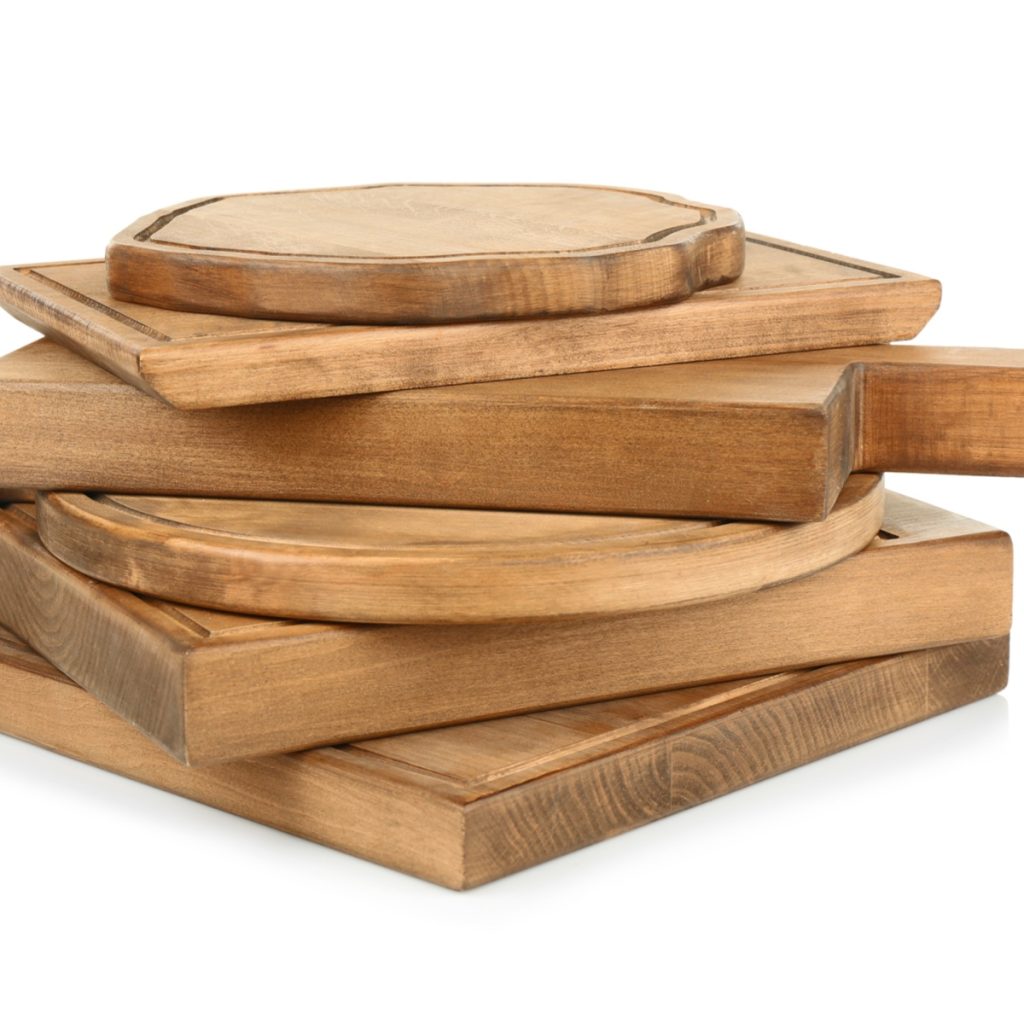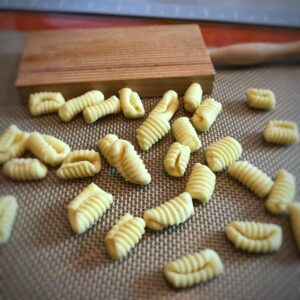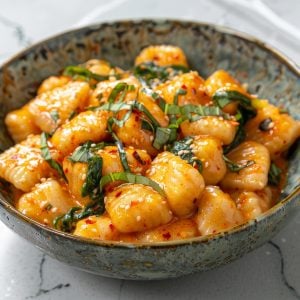How to Choose The Right Cooking Board
When choosing the right cutting board for your kitchen, chefs, home cooks, and health experts have long debated the pros and cons of wood and plastic. Both materials offer distinct advantages and potential drawbacks, influencing hygiene, durability, and maintenance.
Wood cutting boards, often praised for their natural aesthetics and knife-friendly surfaces, are beloved by many for their traditional appeal. However, concerns about their ability to harbor bacteria and their need for regular oiling to prevent cracking can be off-putting.
On the other hand, plastic cutting boards are favored for their ease of cleaning and affordability. They can be tossed in the dishwasher for thorough sanitization, but their surfaces are prone to deep cuts, creating perfect hiding spots for bacteria if not properly maintained.
This post will delve into the key differences between wood and plastic cutting boards, examining their pros and cons to help you make an informed decision for your kitchen. Whether you prioritize sustainability, sanitation, or simplicity, understanding these factors will ensure you choose the cutting board that best meets your culinary needs.
What are the Benefits of Wooden Cutting Boards?
Wooden cutting boards offer several benefits that make them a popular choice among chefs and home cooks:
- Knife-Friendly Surface: Wooden cutting boards are gentle on knives, helping to maintain their sharpness longer. Wood’s soft yet durable surface reduces the wear and tear on knife edges compared to more complex materials like glass or ceramic.
- Self-Healing Properties: Wood’s fibrous nature allows it to absorb and recover from knife cuts more effectively than plastic. Over time, small cuts and grooves in a wooden board can “heal” as the wood fibers swell and close up, making the board less prone to deep grooves where bacteria can hide.
- Natural Antibacterial Properties: Certain types of wood, such as maple and bamboo, have natural antimicrobial properties. Studies have shown that wood can be less prone to harboring bacteria than plastic, as bacteria tend to die off more quickly on wooden surfaces.
- Durability and Longevity: With proper care, high-quality wooden cutting boards can last for many years. They are generally more robust and resilient than plastic boards, which can become deeply scarred and need to be replaced more frequently.
- Aesthetic Appeal: Wooden cutting boards add a warm, natural look to any kitchen. They can also double as attractive serving platters for cheese, bread, and other foods, making them versatile and stylish kitchen tools.
- Eco-Friendly: Wood is a renewable resource, and many wooden cutting boards are made from sustainably harvested timber. They are biodegradable and can be recycled or repurposed at the end of their life span, making them a more environmentally friendly option compared to plastic.
- Customizability: Wooden cutting boards come in various shapes, sizes, and wood types, allowing for greater customization to fit personal preferences and kitchen needs.
By considering these benefits, it’s clear why wooden cutting boards remain a favored choice for many who value performance, aesthetics, and sustainability in their kitchen tools.
What are the Disadvantages of Them
While wooden cutting boards offer numerous advantages, they also come with some disadvantages that can affect their usability and maintenance:
- Maintenance Requirements: Wooden cutting boards require regular maintenance to keep them in good condition. They need to be oiled periodically to prevent them from drying out, cracking, and warping. This can be time-consuming compared to the low-maintenance requirements of plastic cutting boards.
- Potential for Bacterial Contamination: Wood has natural antibacterial properties but can still harbor bacteria if not cleaned and dried correctly. Deep cuts and grooves in the wood can trap food particles and moisture, creating an environment for bacteria to thrive. Thorough cleaning and regular maintenance are essential to mitigate this risk.
- Sensitivity to Moisture: Wooden cutting boards are susceptible to damage from excessive moisture. They should not be soaked in water or put in the dishwasher, as this can cause the wood to swell, warp, or crack. Proper drying after each use is crucial to maintaining the board’s integrity.
- Initial Cost: High-quality wooden cutting boards can be more expensive than plastic ones. The initial investment might be higher, but their durability and longevity can offset this cost.
- Weight and Size: Wooden cutting boards are generally heavier than plastic boards, making them more cumbersome to move and clean. Their weight can be a drawback for those who prefer lightweight, easy-to-handle kitchen tools.
- Staining and Odors: Wood is porous and can absorb strong odors and colors from certain foods, such as onions, garlic, and beets. This can result in lingering smells and stains that are difficult to remove, requiring extra care and cleaning techniques.
- Not Dishwasher Safe: Wooden cutting boards cannot be cleaned in a dishwasher, as the high heat and prolonged exposure to water can damage the wood. This means they require manual washing, which can be less convenient than simply placing a plastic board in the dishwasher.
By weighing these disadvantages against the benefits, you can determine whether a wooden cutting board is right for your kitchen and cooking habits.
What are the Benefits of Plastic Cutting Boards?
Plastic cutting boards offer several advantages that make them a popular choice in many kitchens:
- Ease of Cleaning: Plastic cutting boards are non-porous and can be easily cleaned. Most plastic boards are dishwasher safe, allowing for thorough sanitization with minimal effort. This makes them a convenient option for busy kitchens where hygiene is a priority.
- Affordable: Plastic cutting boards are generally less expensive than wooden boards. Their lower cost makes them an attractive option for budget-conscious consumers or for use in situations where boards might need to be replaced frequently.
- Lightweight and Portable: Plastic cutting boards are typically lighter than wooden boards, making them easier to handle, move, and store. Their lightweight nature is beneficial for tasks that require frequent lifting and shifting of the board.
- Variety of Colors and Sizes: Plastic cutting boards come in various colors, sizes, and thicknesses. This variety allows users to choose boards that best suit their specific needs and preferences. The different colors can also be used to color-code boards for different types of food, reducing the risk of cross-contamination.
- Resistant to Stains and Odors: High-quality plastic cutting boards are less likely to absorb stains and odors than wooden boards. This makes it easier to keep clean and fresh, even after cutting foods with strong colors or smells.
- Durable and Long-Lasting: Plastic cutting boards can develop knife marks over time, but high-density plastic boards are pretty durable and can withstand heavy use. They do not crack or warp like wooden boards; if they become too worn, they are relatively inexpensive to replace.
- Hygienic Surface: Plastic cutting boards’ non-porous surface makes them less likely to harbor bacteria than wooden boards. Proper cleaning can effectively remove any bacteria present, making plastic boards a safe choice for food preparation.
- Versatile and Practical: Plastic cutting boards can be used for various tasks beyond cutting, such as serving or as a base for rolling dough. Their practicality extends to being lightweight, making them easy to transport for outdoor cooking or picnics.
Considering these advantages, plastic cutting boards can be seen as a practical, cost-effective, and hygienic option for many kitchens.
What are the Disadvantages of Them
Plastic cutting boards have several disadvantages that might make them less appealing for some users:
- Knife Damage: Plastic cutting boards are prone to developing deep grooves and cuts from knives. If not properly cleaned and sanitized, these grooves can become a breeding ground for bacteria, potentially compromising food safety.
- Hygiene Concerns: While plastic boards are generally easy to clean, the grooves and cuts accumulating over time can harbor bacteria, making thorough cleaning essential. Plastic boards can become less hygienic than their wooden counterparts if not maintained well.
- Environmental Impact: Plastic cutting boards are made from non-renewable resources and are not biodegradable. Disposing worn-out plastic boards contributes to plastic waste, which has significant environmental implications. Some plastic boards are also made from materials that may need to be recyclable.
- Potential for Warping: Although plastic cutting boards are generally durable, they can warp if exposed to high heat, such as in a dishwasher with very hot water. Warping can make the board uneven and difficult to use effectively.
- Aesthetic Appeal: Plastic cutting boards are often less attractive than wooden ones. They need the natural, warm look of wood and may not enhance the kitchen’s aesthetic similarly.
- Less Durable: Over time, plastic cutting boards can become deeply scarred and worn out, requiring replacement more frequently than high-quality wooden boards. This can lead to additional costs and more plastic waste.
- Chemical Concerns: Some plastic cutting boards may contain chemicals such as BPA (Bisphenol A), which can leach into food, especially when the board is damaged or exposed to high temperatures. Opting for BPA-free boards can mitigate this concern, but it’s still something to consider.
- Surface Hardness: While plastic boards are generally softer than materials like glass or ceramic, some users find them less gentle on knife edges than wooden boards. This can lead to more frequent sharpening and potential wear on knives.
By evaluating these disadvantages, you can make a more informed decision about whether plastic cutting boards are suitable for your kitchen and cooking practices.

Style
What does the Reluctant Gourmet use?
I now own and use an 8 x 14 wooden board for cutting meat or when I am using it to display an appetizer of cheeses, slices meats, and vegetables, an 11 x 14 Gripper plastic board for small chopping chores, and inexpensive, flexible plastic mats for everyday, quick jobs.
What I really like about the mats is how flexible they are. You can chop up an onion and use the mat to funnel the onion right into a pan. They are also easy to clean and don’t take up much space in the dish drain.








10 Responses
I’ve used wooden cutting boards for over 2 years now. I made my purchase from Amazon and a local retailer. I own 1 end grain wood cutting board and 2 bamboo cutting boards. Works fantastic. This guys blog does a good job as well in laying out all the options – http://www.woodcuttingboardsguide.com
Thanks
Hi. Which is the best cutting board? Plastic? Wooden?
I just wanted to say a word on the debate which seems to continue for decades.
The material which is gentle on blades and offers high antibacterial protection has a name! It is Japanese hinoki wood (Japanese cypress). All the Best//
Good to know Iacopo, thanks.
We’re a manufacturer of hand made wooden cutting boards. We think that everbody needs to know that wood is the best material you can use for a cuttin board. For Hygien, the sharpness of your knives and for your own health (now plastic or RVS parts in your food).
I am a chef, I use a wooden chopping board, but make sure you get one that has all one solid piece, a little bit more expensive, but if you work out you use it every day for the next thirty years or so, not so bad. Also the ones with one solid piece have no glues and some of the glues have dangerous chemical, I use these Byron Bay chopping boards, they use Camphor Laurel timber (antibacterial) Its beautiful timber and hard wearing. Happy Cooking Chef Simon
Many are of the opinion that you should separate the usage of your boards. If you use the wooden board for cutting meats that aren’t meant to be eaten raw, then you shouldn’t use that for other purposes – cheese like you mentioned, or fruits, vegetables, etc.
Along with staining on the plastic boards, those ridges can harbor bacteria and be hard to clean out so really need to be scrubbed.
I have a few different boards, and generally use the wooden board for everyday non-meat use, and use the plastic one for meats.
Those Byron bay chopping boards are the best for your knives and one solid piece
I didn’t realize that there was so much to consider when choosing whether to use a wooden or plastic cutting board. However, I like a lot of the pros and cons that you make about each material and how they stand up to knives. Because of that, I’m more likely to choose a wooden cutting board since it won’t wear down my lives as quickly.
Nice debate. You have rightly pointed out all the things about cutting boards.
I love how you talk about how flexible mats and cutting boards are great to be used for quick cutting. My mom has a lot of old cutting boards that look a little worse for wear and she wants to get a few new ones that look a bit nicer so she can use them to plate food as well. We’ll have to look into finding a place that sells some nontraditional cutting boards to help her look at her options.